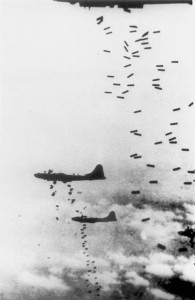ANNIVERSARY OF FIREBOMBING RAID ON TOKYO March 10, 1945
SEVENTEEN MONTHS AGO I PUBLISHED A BLOG ABOUT THE DEADLIEST CONVENTIONAL AIR RAID EVER, USING THE NEWLY INVENTED NAPALM BOMBS. AS THE DEAD TOLL OF THIS FIREBOMBING RAID ON TOKYO EXCEEDED THE DEATH TOLL OF EITHER OF THE ATOMIC BOMBS, WE CAN THINK OF IT AS THE DEADLIEST AIR RAID EVER.
AND YET THE MEMORY OF THIS EVENT IS JUST A FAINT ECHO OF THE EFFECT OF THE ATOMIC BOMBS. WHY DO YOU THINK THAT IS? ONE ANSWER, OF COURSE, IS IN THE LAST PARAGRAPH OF THE BLOG. ANOTHER ANSWER IS THAT THE ATOMIC BOMBS WERE SO SINGLE-PICTURE AND THREATENINGLY PHOTOGENIC. PLEASE TELL US WHAT YOU THINK.
TODAY IS THE 70TH ANNIVERSARY OF THIS EVENT. MY HOPE IS THAT THE JAPANESE GOVERNMENT AND POPULATION AND THE AMERICAN GOVERNMENT AND POPULATION BOTH HAVE FOUND A WAY TO COMMEMORATE THIS HORRIFIC EVENT WHILE SOME SURVIVORS ARE STILL ALIVE. MOST OF THEM WHERE YOUNG CHILDREN WHO INSTINCTIVELY DID THE SMART THING TO SURVIVE.
THE PREVIOUS BLOG IS REPEATED BELOW:
The firebombing raids on Tokyo, codenamed Operation Meetinghouse, were low altitude incendiary bombing raids ordered by General Curtis LeMay.
 The first wave of planes was followed by a procession of bombers sowing death until dawn, touching off devastating firestorms: almost 17 square miles of the city were reduced to ashes. Estimates of the number killed range between 80,000 and 200,000, a higher death toll than that produced by the dropping of either of the atomic bombs on Hiroshima or Nagasaki 5 months later.
The first wave of planes was followed by a procession of bombers sowing death until dawn, touching off devastating firestorms: almost 17 square miles of the city were reduced to ashes. Estimates of the number killed range between 80,000 and 200,000, a higher death toll than that produced by the dropping of either of the atomic bombs on Hiroshima or Nagasaki 5 months later.
Robert Guillain was a French reporter assigned to Japan who was trapped in the country after Japan’s attack on Pearl Harbor. He was in Tokyo on the night of March 9, 1945 and published a book recounting his experiences, “I Saw Tokyo Burning”. This is his description of the start of the raid as the sound of air-raid sirens pierce the night and the first B-29s make their appearance:
“They set to work at once sowing the sky with fire. Bursts of light flashed everywhere in the darkness like Christmas trees lifting their decorations of flame high into the night, then fell back to earth in whistling bouquets of jagged flame. Barely a quarter of an hour after the raid started, the fire, whipped by the wind, began to scythe its way through the density of that wooden city.”
“The first Superfortresses dropped hundreds of clusters of the incendiary cylinders the people called “Molotov flower baskets,” marking out the target zone with four or five big fires. The planes that followed, flying lower, circled and crisscrossed the area, leaving great rings of fire behind them. Soon other waves came in to drop their incendiaries inside the marker circles. Hell could be no hotter.”
The American objective was to shorten the war by demoralizing the Japanese population and breaking its will to resist, but it didn’t work. Once the shock passed, the war work went on.

No comments yet.